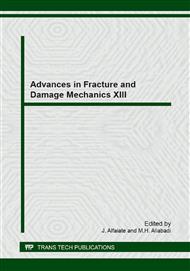p.17
p.21
p.25
p.29
p.33
p.37
p.41
p.45
p.49
A Multiscale Approach to Polycrystalline Materials Damage and Failure
Abstract:
A two-scale three-dimensional approach for degradation and failure in polycrystalline materials is presented. The method involves the component level and the grain scale. The damage-induced softening at the macroscale is modelled employing an initial stress boundary element approach. The microscopic degradation is explicitly modelled associating Representative Volume Elements (RVEs) to relevant points of the macro continuum and employing a cohesive-frictional 3D grain-boundary formulation to simulate intergranular degradation and failure in the Voronoi morphology. Macro-strains are downscaled as RVEs' periodic boundary conditions, while overall macro-stresses are obtained upscaling the micro-stress field via volume averages. The comparison between effective macro-stresses for the damaged and undamaged RVEs allows to define a macroscopic measure of local material degradation. Some attention is devoted to avoiding pathological damage localization at the macro-scale. The multiscale processing algorithm is described and some preliminary results are illustrated.
Info:
Periodical:
Pages:
33-36
Citation:
Online since:
September 2014
Authors:
Price:
Сopyright:
© 2015 Trans Tech Publications Ltd. All Rights Reserved
Share:
Citation:


